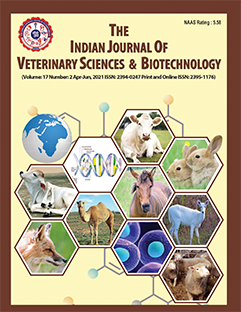Removal of Eleven Live Puppies through Caesarean Section due to Complete Primary Uterine Inertia in a Saint Bernard Bitch
DOI:
https://doi.org/10.48165/ijvsbt.21.3.28Keywords:
Canine pregnancy, multifactorialAbstract
Canine pregnancy, like other polytocous species, undergoes several challenges during gestation and whelping due to multifactorial reasons like hormonal changes, prolonged whelping process, nursing, and subsequent uterine involution. Another factor which drives canine pregnancy as a challenge is the presence of multiple foetuses in utero which demands continuous yet consistent contractile forces to expel them (Arlt et al., 2023). These multiple foetuses predispose the dam to uterine inertia which denotes the lack of contractile forces in the uterine musculature. The primary uterine inertia is the inherent lack of contractile forces and is referred as the cause of dystocia whereas the secondary uterine inertia, which is due to exhaustion and fatigue of uterus resulting in abnormal and ineffective forces, is the result of dystocia. Between these two the primary uterine inertia accounts 40-70% of maternal factors related dystocia cases (Darvelid and Linde-Forsberg, 1994). The incidence of primary uterine inertia is high in bitches and there are various factors which predispose this condition like hormonal imbalance, age, litter size, genetic predisposition etc (Davidson et al., 2011). Primary uterine inertia is further subdivided into two classifications naming partial and complete primary uterine inertia. The partial one results after the initiation of normal labour followed by delivery of one or few puppies but fail to deliver full litter owing to abrupt cessation of myometrial contraction. On the contrary, in the complete primary uterine inertia, the second stage of whelping fails to occur resulting in dystocia (Balamurugan et. al., 2024). This paper reports successful removal of eleven live puppies post-exploratory laparotomy due to complete primary uterine inertia in a bitch.
Downloads
References
Arlt, S.P., Ottka, C., Lohi, H., Hinderer, J., Ludeke, J., Muller E, Weber, C., Kohn, B., & Bartel, A. (2023). Metabolomics during canine pregnancy and lactation. PLoS One., 18(5), e0284570.
Balamurugan, B., Narwade, Priyanka., Mishra, R.M., Kumar, V., Ravi, S.K., Kumar, P.R., & Jena, D. (2024). Dystocia due to complete primary uterine inertia in an American bull bitch. International Journal of Science, Environment and Technology, 13(1), 6-10.
Darvelid, A.W., & Linde-Forsberg, C. (1994). Dystocia in the bitch: A retrospective study of 182 Cases. Journal of Small Animal Practice, 35, 402-407.
Davidson, A.P. (2011). Primary uterine inertia in four Labrador bitches. Journal of American Animal Hospital Association, 47(2), 83-88.
Noakes, D.E., Parkinson, T.J., & England, G.C.W. (2019). Veterinary Reproduction and Obstetrics. 10th edn. Saunders Elsevier, England, pp. 330-332s.
Downloads
Published
Issue
Section
License
Copyright (c) 2025 Indian Journal of Veterinary Sciences and Biotechnology

This work is licensed under a Creative Commons Attribution-NonCommercial-NoDerivatives 4.0 International License.




